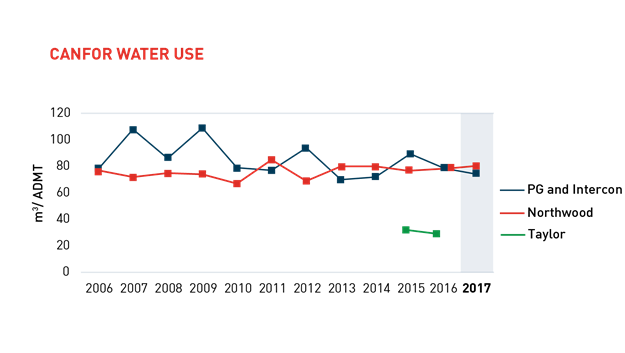Water Resources
Pulp and paper mills, including Canfor Pulp’s mills in Prince George and Taylor, are heavily dependent on water. British Columbia’s climate has changed over the last 100 years, and we expect this will continue with warmer and wetter conditions in the future. Higher local temperatures and rainfall will lead to unbalanced conditions within local watersheds.
In Prince George, we draw water for our mills from the Nechako and the Fraser Rivers. During 2017, our mills used 78 cubic metres of water per air dry metric tonne of pulp and paper produced. Approximately 98% of the water we process is discharged to the river, and only 2% is actually consumed in the process.
Our pulp mills continue to develop process optimization opportunities to reduce process water requirements, and were able to achieve a 5% reduction through hot and warm water system changes. While the water we consume represents less than 2% of the volume, we have been working with researchers at the University of British Columbia to understand how these flows may change.
Canada is a world leader on requiring industrial facilities to measure the more subtle effects of effluent on the environment, and eliminate them if there are negative impacts. For over 20 years, its Environmental Effects Monitoring has ensured that Canadian pulp and paper facilities operate with minimal impacts on water resources by looking for potential effects on fish and benthic invertebrates that make up the ecosystem. Our pulp and paper mills operate in full compliance with these strict regulations.
We finalized work on raising the berm at the Northwood pulp mill’s outfall lagoon in 2017. It now meets a 200-year flood level, avoiding overflows into the Fraser River. We also built new fish habitat as part of the project. The outflow lagoon receives treated effluent from the Northwood mill and releases it into the Fraser River through a submerged diffuser.
